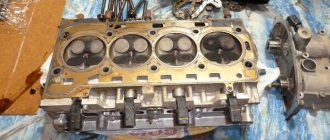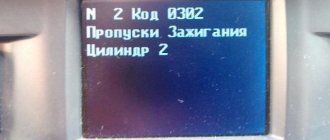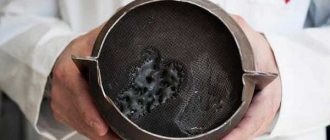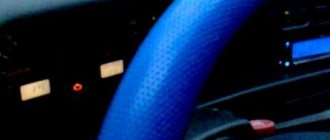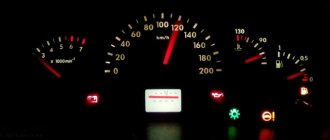Do you experience misfires at idle or under load? Misfire is one of the most common problems when it comes to modern gasoline engines. The spark is critical to the operation of the engine.
There are many reasons that can cause a misfire. They are not easy to eliminate, especially if you don’t know where to look for them.
In this guide, we'll look at the symptoms of misfires, their causes, and how to best troubleshoot them.
How does a mechanic diagnose trouble code P0304?
When diagnosing the P0304 trouble code, a mechanic will do the following:
- Connects the OBD-II scanner to the vehicle's diagnostic connector and reads all stored error codes.
- Reviews all data stored in the ECM memory.
- Clear error codes from the ECM and test drive the vehicle to see if P0304 appears again.
- Inspects major ignition system components and associated wires for wear and damage, and performs a thorough check for leaks.
- Check the misfire counter in cylinder 4.
- Will check if there is an intake air leak or any problems with fuel injection.
How does the ECU know when misfires occur?
The ECM may detect misfires differently depending on the vehicle model and engine. The ECU uses many sensors to know when to fire the spark plug, when to inject fuel into the cylinder, and how to change the air-fuel mixture. To detect misfires, the control unit often uses a crankshaft sensor.
Engine ECU
The crankshaft sensor measures the position of the crankshaft and calculates its revolutions per minute. The crankshaft sensor uses the camshaft sensor to determine which cylinder is at top dead center and ready to ignite.
Pushing the pistons down causes a slight increase in crankshaft speed. If the crankshaft sensor does not recognize this increase in speed, the engine control unit will store a fault code on the cylinder on which the misfire occurred.
Sometimes the control unit cannot determine which cylinder is misfiring and it stores the error code P0300 (random misfire).
Some ECUs use ignition coil resistance. When ignition does not occur, the control unit understands this through the electrical wiring, which leads to an error. This method is not as common as detection using the crankshaft sensor.
Additional comments for troubleshooting P0304
To properly diagnose a P0304 trouble code, a mechanic will need an advanced scanner that will not only read stored trouble codes, but also view sensor readings in real time. This data can help determine the root cause of the error.
The recommended service interval for replacing spark plugs is usually indicated in the vehicle's service book. Worn or damaged spark plugs are one of the most common causes of cylinder misfire, especially in high-mileage vehicles. If the vehicle is equipped with an ignition distributor with a cap and slider, these must also be replaced according to the vehicle manufacturer's recommendations. These components are mechanical and wear out over time. Spark plug wires are usually replaced when the spark plugs themselves are replaced.
Newer vehicles may be equipped with ignition coils, which typically last longer than the above components. To quickly determine whether the problem is a faulty ignition wire or coil, you must move the wire and/or ignition coil to a different cylinder. If the error code appears again, it is a sign that a worn or damaged ignition wire and/or coil is causing the cylinder to misfire.
What is a misfire?
To know what a skip actually is, we first have to start with the basics of how a car engine works.
Here you can see a good illustration of how the pistons and crankshaft move inside the cylinder when the engine is running. The pistons are pushed down by an explosion inside the cylinder. The piston, moving down, rotates the crankshaft. The operation of an engine can be divided into four stages, which is why this type of engine is called a four-stroke engine.
- The piston moves down, filling the cylinder with the air-fuel mixture from the intake.
- The piston goes up, compressing the air-fuel mixture to high pressure.
- A spark from the spark plug ignites the air-fuel mixture and the explosion pushes the piston down, rotating the crankshaft.
- The piston rises up, squeezing the burnt air-fuel mixture through the outlet.
- Repeat the process from step 1.
This is a description of the operation of a four-stroke engine, which is installed in almost all modern cars. There are some older cars that use a 2-stroke engine, but we won't cover them.
A misfire occurs when one or more of these steps are incorrect or missing.
- The air/fuel mixture is too lean or too rich.
- Bad ignition spark, incorrect ignition timing.
- Low compression, accounting for the air-fuel mixture.
- Incorrect timing of intake or release of the air-fuel mixture.
Now you know the basics of how a cylinder works in a car engine and at what stages misfire can occur. With this knowledge it is much easier to find the reason why misfire occurs.
As you can see, in theory there are not many reasons. But when you start diagnosing your car, you'll realize that it's not always that easy to find the problem. Let's continue to learn how to diagnose and how to fix misfires at home.
How does error P0300 affect engine performance?
Before diagnosing, the driver can easily determine from the vehicle's behavior that the diagnostic scanner will indicate error P0300, P0301, or another of the series. Symptoms of engine operation with the error in question are characteristic of a misfire problem:
- The engine shakes violently at low speeds and at idle;
- When accelerating, the car “throws and jerks”;
- Fuel consumption increases significantly;
- There may be problems starting the engine;
- Craving decreases.
If these symptoms occur and the Check Engine light is on on the instrument panel, you can rest assured that the diagnostic scanner will show one of the P0300 family of errors.
Symptoms of malfunction
The main driver symptom of P0304 is the MIL (Malfunction Indicator Light). It is also called Check engine or simply “check light”.
They can also appear as:
- The “Check engine” warning light on the control panel will light up (the code will be stored in the ECM memory as a malfunction).
- The engine stalls or has trouble starting.
- Floating speed, as well as attempts to stall at idle.
- Jerking/misfire at idle or under load.
- Poor speed gain.
- Increased fuel consumption.
- Reduced engine power.
- Smell of fuel from the exhaust.
This malfunction is considered serious and must be corrected as soon as possible. Because prolonged driving with a misfire can cause costly damage to the engine and catalytic converters.
Finding the reason
A misfire means the fuel is not being processed in the combustion chamber. This can happen for a variety of reasons. To determine the root of the problem, all options must be tested. Starting from the simplest to deeper problems. The search should be done in the following order:
- They usually start with the spark plugs. This is the most common cause of cylinder failure. First you need to inspect the candle visually. In working condition, it should be light sand color. If the spark plug is black or gray, you need to clean it. To do this, it is annealed over fire and cleaned with fine sandpaper. Another equally common cause of spark plug failure is a broken gap. It can be both large and small. To eliminate the malfunction, the electrode is pressed out or, on the contrary, pressed, adjusting the gap. After all the steps, you should check the operation of the candle. The spark it creates should be white and blue. This is described in detail in the article “What should be the gap on the spark plugs”;
- Faulty injectors. Engine trouble often occurs due to problems with the condition of the injectors. Usually this malfunction is shown by computer diagnostics. The cause is often poor quality fuel. It clogs the injectors and they stop functioning normally. This can be treated by flushing the power system; in extreme cases, you will have to replace the faulty part. This problem can occur on both gasoline and diesel units;
- Low compression. This is checked by measuring this indicator. If it is less than 11 points, then measures should be taken to repair the engine;
- Incorrect timing adjustment. This usually occurs due to wear of drive parts. Sometimes the reason is a failure in the settings of the hydraulic valve compensators;
- Air entering the fuel system. This could be damage to the intake manifold or a change in the condition of the injector rings. Most often, this problem is accompanied by misfires in different cylinders. You should find the cause and remove it.
On which cars is this problem most common?
The problem with code P0304 can occur on different machines, but there are always statistics on which brands this error occurs more often. Here is a list of some of them:
- Audi (Audi a4, Audi a6, Audi TT)
- BMW (BMW E46)
- Chery (Chery Tiggo)
- Chevrolet (Chevrolet Aveo, Cobalt, Cruz, Silverado, Spark, S-10)
- Chrysler (Chrysler Voyager, PT Cruiser)
- Citroen
- Daewoo (Daewoo Nexia)
- Dodge (Dodge Durango, Caravan, Ram)
- Fiat
- Ford (Ford Mondeo, Mustang, Fiesta, Focus, Fusion, Expedition, F-150)
- Honda (Honda Accord, Odyssey, Pilot, SRV, Civic)
- Hyundai (Hyundai Accent, Getz, Santa Fe, Solaris, Sonata, Tucson, Elantra)
- Jeep (Jeep Wrangler)
- Kia (Kia Rio, Sid, Sorento, Spectra, Sportage, Cerato)
- Lexus (Lexus gx470, rx300)
- Mazda (Mazda 3, Mazda 323, Mazda 6, Mazda cx7)
- Mercedes
- Mitsubishi (Mitsubishi Outlander, Karisma, Lancer, Montero, Pajero, L200)
- Nissan (Nissan Qashqai, Note, Tiida, X-Trail)
- Opel (Opel Astra, Vectra, Vivaro, Zafira, Corsa, Meriva)
- Peugeot (Peugeot Boxer)
- Pontiac (Pontiac Bonneville)
- Renault (Renault Duster, Logan, Megan, Sandero)
- Skoda (Skoda Yeti, Octavia, Superb)
- Ssangyong (Sanyeng Aktion, Kyron)
- Subaru (Subaru Legacy, Forester)
- Suzuki (Suzuki sx4)
- Toyota (Toyota Avensis, Camry, Corolla, Prius)
- Volkswagen (Volkswagen Golf, Jetta, Caddy, Passat, Polo Sedan, Touareg, Tiguan, Transporter)
- VAZ 2105, 2110, 2111, 2112, 2114, 2115
- Volga Cyber
- Gazelle Business, umz 4216
- Lada Granta, Kalina, Niva, Priora
- UAZ Patriot
With fault code P0304, you can sometimes encounter other errors. The most common ones are: P0171, P0202, P0204, P0300, P0301, P0302, P0303, P0305, P0306, P0308, P0354, P0402, P0420, P130A, P1399, C1201.
Communities › Lada Granta › Forum › Errors P0363 and P1304
Hi all. Today I tuned up the engine and the BC showed the following errors: P0363 - Misfires detected, fuel supply to idle cylinders is turned off. P1304 - misfire detected, critical for the converter in cylinder 4. This has already happened (tripleting), but there was no bk and I don’t know the codes. Then I changed the spark plugs and everything went away. Now replacing the spark plugs did not help. Who can help with advice? I don’t want to go straight to the service center, I hope I can fix it myself.
Maybe a coil then?
I've read a lot about this problem. Maybe I/O wires, maybe a coil. maybe something wrong with the injectors. Or do the valves need to be adjusted?
Well, I don’t know then, if you change everything at random, it will probably be a little expensive?! or try removing it from the donor)
I'll check the wires tomorrow. if they are ok, I’ll go for diagnostics
it is truth too! write back later, interesting.
I also had triplets, also 8-grade, there was no BC, I took it to the nearest service center for diagnostics. 15 minutes and the verdict - ignition coil Price: 700 rubles + 200 for diagnostics
There was a letter about low-quality coils and their replacement under warranty. In April, one of mine burned out - they replaced it under warranty. Two weeks ago, during scheduled maintenance, everything was changed. The letter itself with the list of cars is here on the forum. www.drive2.ru/c/1082768/
you have 16 valves, and the vehicle has an 8-valve 87 mares, a different engine, a different ignition coil
Why did the spark plugs require replacement the first time? Maybe gasoline with additives and red spark plugs? Are the candles brick white now? Red ones are additives to gasoline based on metal oxides - they create conditions for breakdown of the insulator.
The problem with the injectors should give itself away while driving - it won’t drive normally. BB wires, if they do not touch metal, are also unlikely to be sewn somewhere.
There may also be poor pressure in the fuel rail, and due to the heat (closeness of the exhaust to the intake), there may be vapor locks in gasoline when the pressure decreases - as an option. Under load, gasoline is consumed faster and cools itself. If the BC is multitronics, then you can look at the injection time graph to see if there are any sudden jumps in fuel supply time.
And it’s not entirely clear whether this problem doesn’t go away? I also encountered misfires at home (the multitronics BC showed an error, on the shuttle BC one-time misfires are not yet displayed). I didn’t even understand whether the engine was damaged or not, because... The error occurred 3 times in 2 months at xx after starting the engine.
My spark plugs had a reddish coating, then I immediately changed the gas station, but still didn’t change the spark plugs.
I changed the spark plugs for the first time for prevention. I installed some French ones. There were 3 times when the check light came on, the car stalled and stopped driving. The officials shrugged their shoulders. Then I realized that it was the candles (it was just that during the next “attack” I put in new candles and everything went away), but now it didn’t help. but here’s the thing: in the morning, two days ago, I swapped the wires of the second and fourth cylinders (both on the spark plugs and on the ignition module) and the error changed to 1301 (it was 1304). but I never understood why. In the end, after about 20 minutes the car started moving, I cleared the errors and everything was okay. It seems that only diagnostics will reveal the problem
What's the result?
Taking into account the above, it becomes clear that in some cases it is not possible to immediately determine the cause of the misfire. It happens that a powerful spark is formed on the spark plugs, the timing is normal, the valves are adjusted, there are no comments on compression. Also, there is normal pressure in the fuel rail, and the fuel pump itself stably provides the specified performance.
As practice shows, in such cases the electrical circuits of the injectors are often to blame. For example, the engine may stall when cold, although after warming up the operation returns to normal. The complete opposite can be considered misfires after the internal combustion engine reaches operating temperature.
The fact is that it is enough that one wire to the injector “shorts”, as a result of which the injector works intermittently, and the problem itself manifests itself to a greater or lesser extent in certain operating conditions of the internal combustion engine (on a cold engine, after heating, under exposure to vibration when driving, etc.).
Finally, we add that this statement is also true in the event of malfunctions of the ECM sensors. As for spark plugs, during normal testing they may produce a good spark in the open air, but while the engine is running, there may no longer be such a spark. The fact is that spark plugs in the combustion chamber operate under high pressure conditions.
This means that the sparking process occurs when the piston compresses the mixture in the cylinder. To diagnose and check functionality, it is recommended to test the elements in a special device that creates conditions similar to the actual operation of spark plugs inside an internal combustion engine.
Is the mixture lean or rich?
Another phenomenon that leads to breakdown is a lean or enriched mixture. If the composition is excessively saturated with oxygen or a flammable substance, the proportions are violated and ignition occurs too early or, on the contrary, late. Problems in the power system in this case are explained by faulty injectors, air leaks at the inlet, or the need to replace the air filter.
Also, an incorrect mixture in the engine can be a consequence of poor-quality chip tuning. Because chip tuning is essentially changing the factory mixture calibrations, using special equipment, to a richer or leaner mixture.
Diagnostics using a computer
If your car is equipped with a modern control unit, then this greatly simplifies troubleshooting; otherwise, you will have to use time-tested old-fashioned methods.
By connecting the computer to the car, you can find out in which cylinder, 1, 2, 3 or 4, and for what reason there are misfires, for example, the ignition coil or one of the injectors has failed.
But in any case, before going to a car service center, you need to check the condition of the spark plugs, injectors, high-voltage wires, how the exhaust system works, and whether there is smoke from the exhaust pipe.
Many car owners cannot afford instruments for car diagnostics, these include scanners (software and portable), motor testers, oscilloscopes, gas analyzers and other devices, and you need to be able to use them, read error codes, and so on. Although if you look into it, there is nothing complicated there.
The scanner is connected to a special connector, which can be located in different places in each car model, but it has one function: diagnostics.
Next, error codes are read from the control unit and decrypted.
For example, VAZ 2110, 2114, 2115, Lada Kalina, Priora, Granta cars have the following error codes that are characteristic of misfire:
- P0300 - a large number of misfires;
- P0301, P0302, P0303, P0304 – misfires in cylinders 1, 2, 3 and 4, respectively;
- P0300 - a large number of misfires in a random order;
- P0301, P0302, P0303, P0304 – misfires were detected in 1, 2, 3 and 4, respectively;
- P0363 – see point 4 + fuel supply to problem cylinders is stopped;
- P1301, P1302, P1303, P1304 – respectively, misfires dangerous for the catalytic converter were detected in cylinders 1, 2, 3, 4;
- P0300, P0301, P0302, P0303, P0304 – detection of misfires affecting the toxicity of exhaust gases;
- P0363, P1301, P1302, P1303, P1304 – the same as in point 7, but affecting the catalyst;
- P0351, P0352, P0353, P0354 – open circuit in the ignition coil in the control circuit 1 (1-4), 2 (2-3), 3, 4;
- P2301 P2303 P2305 P2307 - short to on-board network in the coil in the control circuit of cylinders 1 (1-4), 2 (2-3), 3, 4;
- P0201, P0202, P0203, P0204 – respectively, open circuit for controlling injectors 1,2,3,4;
- P0261, P0264, P0267, P0270 - short circuit of the injector control wires to the body, respectively, in the 1st, 2nd, 3rd, 4th center;
- P0262, P0265, P0268, P0271 – the same as point 12, but only to the on-board network;
- P1500 – electric fuel pump relay, wire break.
Diagnostics of VAZ 2109, 2110, 2114, 2115, Kalina, Priora, Granta
Let's look at misfires using the example of the VAZ 2109, 2110, 2114, 2115, Kalina, Priora, Granta models.
The computer generated error P0303 (misfire in 3rd crank).
First you need to understand how the ignition coil works. It consists of two small coils, pins 1 and 4 are connected to the first, and pins 2 and 3 to the second.
Those. during operation, voltage is simultaneously supplied to the first and fourth cylinders or to the second and third.
We have misfires in cylinder 3. Remove the wires from 2 and 3 and swap them.
Start the engine and see if the error has moved to cylinder 2, then the problem is most likely in the high-voltage wires or in the coil itself, and they need to be checked first.
High-voltage wires are tested by checking their resistance. To do this you need a regular multimeter.
Set the resistance measurement mode to 20 kOhm.
In our case, we check the third wire. If the device shows numbers within the range of 3.5 - 10 kOhm, then the wire resistance is considered normal, otherwise it changes.
Next we check the coil. For this you will also need a multimeter.
We measure the resistance between 1 and 4 and 2 and 3 coil terminals. Readings of 10 kOhm, or around this figure, are considered standard.
Important. During testing, the tester should not show 1. This means that there is an open circuit in the circuit and the coil is faulty.
Next we check the resistance between each terminal and ground. In this case, on the contrary, the multimeter should show 1 (infinity).
If resistance is shown at one of the terminals, it means that its insulation is damaged and it is connecting to ground. Accordingly, the required voltage will not be supplied to form a spark.
Next, we check the resistance between the central terminal of the ignition coil and the housing (ground). It should also be equal to infinity, i.e. 1.
Now it remains to check the resistance between the extreme terminals. To do this, set a different measurement limit on the device - 200 Ohms.
A resistance of 2 ohms is considered normal (+-). There should be no break between the extreme terminals.
Next, check the condition of the contacts on the coil itself and on the wires; they tend to oxidize over time, especially if your region of residence has a humid climate.
If the error remains in cylinder 3, but the coil and high-voltage wires are in good condition, we check the spark plug.
The easiest option is to remove the spark plug from the working cylinder and swap them.
If the error then transferred to another cylinder, then most likely the issue is in the spark plug.
If nothing has changed and the error remains, then check the injectors.
In this case, you also need a multimeter. Disconnect the wires from the injector, in our case from cylinder 3, and measure the resistance, it should be about 13 ohms.
Next, check the injector power supply circuit. Also, the injector may become clogged and not supply the required amount of fuel, which can cause misfires. Therefore, you will have to clean the injectors.
If after all the above checks the misfires have not disappeared, you need to check the valve clearances.
The valves should not be tightly clamped, as this will lead to their incomplete closing, and this, in turn, will lead to a decrease in compression and compression ratio in the cylinders and this will cause misfires. Also, if you press too hard, the valve may burn out.
Diagnosis and problem solving
Sometimes, when P0304 is detected, no symptoms are observed. The easiest thing to do in this case is just reset the code and see if it comes back.
If the problem manifests itself in the form of uneven idle or engine jerking, check all wiring and connectors leading to the cylinders. Next, it’s worth checking the spark plugs, wires, and coils.
In some cases, the cause is a failed catalytic converter. If you smell a rotten egg smell in your exhaust, the catalytic converter needs to be replaced. Faulty fuel injectors should also not be overlooked.
Random misfires may be due to lean fuel. This may be due to a vacuum leak in the intake manifold or air flowing past the airflow sensor. And also because of the exhaust gas recirculation valve stuck in the open position.


